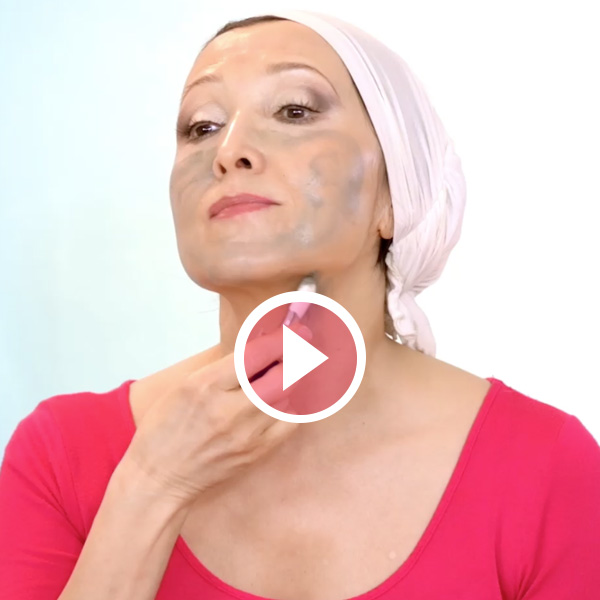Skincare for Sensitive Skin
Published: (October, 2022)


Why Your Skin is Sensitive
Your skin tells the story of what’s going on underneath it, of what’s going on inside of you.
Skin constantly breaking out, inflamed or burning, crying out for soothing and medication…these are warning signals. When sensitive skin flares up, it’s called many things: acne, dermatitis, rosacea, redness, burning, stinging. But all of the above share the same cause—inflammation.
People with sensitive skin show inflammatory responses either to external causes (cosmetics, sunlight) or internal ones (food, drink, medication). Sensitive skin results from many causes, but the diet is often at the root. Cooked foods create sensitivity and inflammation—most especially foods high in sugar.
Alcohol is a serious offender. Many people swear by a nightly glass of wine or two to relax. But alcohol also affects your brain’s capacity for vascular control, causing blood to rush to the surface. The more you drink, the more redness and sensitivity you experience.
Years of sun exposure can affect the tiny blood vessels under your skin, creating an overall reddish hue. Solar UV radiation penetrates the skin and produces mutations that changes your skin’s color and texture.
This email came: …As I get older, my skin becomes more red and blotchy. I used to have porcelain skin.
For many people the skin becomes too sensitive, as they get older. On the internet I came across one dermatologist’s verdict for sensitive skin: "There is no cure, but with proper attention and care, it can be managed."
But I believe that with diligent skincare you can still have what people call a “beautiful complexion” even in your sixties and beyond. I fully intend to take good care of my skin no matter how “old” I might be privileged to be.

The Biggest Favor You Can Do for Your Skin
Eat lots of raw fruits and vegetables. While you’re at it, begin a daily juicing practice. Celery juice or green vegetable juices are the best.
What you put into your body is every bit as important as what you put on your skin. I can’t stress enough how much you and your skin will benefit from eating plenty of raw fruits and vegetables high in antioxidants. These will target the free radicals that stimulate blood vessels and tissues to become red and inflamed.
Don’t forget the omega-3 fatty acids, which help prevent inflammation. You’ll find these fatty acids in walnuts, flaxseed, hemp seeds, and chia seeds.
Do be patient. Your improved diet will reduce the redness and sensitivity of your skin. But it will take a few weeks, even months before you see any changes.

How to Handle Your Sensitive Skin
Conventional wisdom calls for kid-glove handling of the skin, babying it and thereby alleviating undesirable symptoms. The reason: People on conventional diets have especially sensitive, often troubled skin. Rubbing or exfoliating such skin can cause it to tear. Their fragile blood vessels are easily broken. Breakouts happen even after so much as applying oil, or having a massage, or following a gentle exfoliation.
Whatever skin issue you might have—redness, acne, broken capillaries, or simply sensitivity—the worst thing you can do is…(you guessed it) nothing.
Most people think: I better not touch it or it’ll get angry and react. But neglect will lead to your skin’s becoming covered in more and more dead cells. The skin’s remarkable ability to rejuvenate is then hijacked. And those skin issues will only get worse.

Home Remedies for Sensitive Skin
Cucumber masque
Nicholas Culpeper, a 17th century doctor and botanist, wrote extensively about the cucumber’s ability to clear redness from the face. Grate a cucumber or run it through a food processor. Apply the cucumber to the face. Let sit for 15 minutes and gently rinse off with cool water. For added benefit, chill the cucumber before use.
Green tea
Green tea makes a reliable, low-cost, natural topical wash. It contains polyphenols, which aid in skin-cell rejuvenation. Peppermint tea is also great for soothing red skin. Whichever you choose, simply steep a few bags in very hot water for 10 to 15 minutes. Remove the bags from the liquid, then cool the liquid in the fridge. Pour the cool liquid onto a washcloth and press onto your red areas for 1 to 2 minutes.
Argan oil
Argan oil has a long history of beneficial results for skin and hair. It contains vitamin E and natural inflammatory properties that soothe and heal the skin. Be careful when buying, however. If it’s not labeled as organic and 100% pure, it’s probably been diluted, which lowers its effectiveness.
Colloidal oatmeal masque
Usually recommended for eczema, colloidal oatmeal is also great at treating most facial redness. Colloidal oatmeal is oats that have been very finely milled. You can quite easily make your own. Buy some organic oatmeal—not the instant kind! Grind the oats in a coffee grinder, a kitchen mill, or a blender. Even a mortar and pestle will do in a pinch. Pour a few teaspoons of the ground oatmeal into your hand and add enough water to make a paste. Apply this to your skin, let it dry, then rinse it off.
Honey masque
Honey has natural, anti-inflammatory properties and is a great moisturizer. Rinse your skin in tepid water, then apply organic honey liberally to the affected areas. Leave this on for 30 to 45 minutes, rinse off with warm (not hot) water, and pat your skin dry.
Avocado masque
If your skin is red and irritated because of extreme dryness, try this quick fix. Mash a ripe avocado, apply the mash to your skin. Let it sit for 15 to 20 minutes, rinse off with cool water, and pat your skin dry.
And after juicing daily for 4 to 6 weeks and doing these mask treatments every day, you’ll start to see improvements.

Skin Blemishes… Begone!
At various times, I’ve experienced burns, scars, and broken capillaries, all of which, I thought would remain permanent. Yet, because I’m totally dedicated to skincare, sooner (sometimes weeks) or later (months or even longer), the blemishes went away. Know this: With the right natural skincare, a skin blemish always gets less visible, and will often disappear completely. Just be diligent and patient.
Intelligent skincare, I believe, is essential for achieving a beautiful complexion in the long run. By “intelligent” skincare, I don’t mean a skincare routine that was given to you by a dermatologist. (although they can be of great help in a critical-care situation) nor one suggested by some expert cosmetologist or blogger. It’s the one developed by you, keeping a continuous “conversation” with your skin.
Use my books, newsletters, and posts for ideas only. Try one of the practices I suggest, at first very gently. Watch for your skin’s feedback. It’ll talk to you. Find out what works and what doesn’t work for you skin. The main thing: Never neglect it and you’ll be rewarded.

The Secret Benefit of Routines
I like the quote by John C. Maxwell: "You'll never change your life until you change something you do daily. The secret to your success is found in your daily routine."
Maxwell’s maxim fits perfectly when it comes to your health and your complexion. Any success I may have achieved in slowing my aging came because I love smart routines.
Any regular health-giving practice, including your skincare routine, gives a sort of equanimity, a stable base during life’s turbulent times. It’s certainly been that way for me.
I believe it’s essential to train your skin to a daily facial mask. Watch my short video above.
If you have especially sensitive skin, try one of the simple homemade masks I suggested above. You can also try our Green Essence or BerryBright masques. Both are very gentle, especially if you keep them on for just one or two minutes. See my article Which Facial Mask Should You Use?
